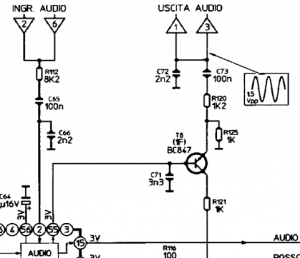Stereo to Mono Conversion
For whatever reason, it may be desired to combine two line-level audio channels: here, some approaches are presented.
The connectors involved may or may not complicate matters: RCA (or other independent and interchangeable equivalents) is assumed in this article and, generally, offers the most freedom.
Connecting only one channel
An approach actually recommended by multiple pieces of consumer equivalent, the additional cable is left disconnected. Which one is up to the user's discretion, although one is typically mentioned in the manual, usually without particular significance.
The result may still be satisfactory (especially with most phonorealistic content), or significant parts of the content may go missing - potentially all of it.
Software mixing
A fair amount of consoles and/or their games, and newer computer/mobile operating systems, offer an option to combine channels (the latter, usually touting it as an accessibility feature).
As the various output channels are then made to be equal, the above strategy can now be carried out with generally better results.
Note that open air (non-headphone) multi-channel listening allows for, and sometimes deliberately employs, phase-cancellation effects.
Direct connection
With this technique, the two channels are directly connected together.
While often looked down in favor of the following method, it is not that uncommon in consumer equipment (as shown in the picture) and, at typical small-signal levels, not dangerous for the source (compare with the possibility of one or more channels being fully shorted to ground using common consumer connectors).
"Splitter" RCA and Jack adapters typically implement this configuration.
Resistive combination
The two channels are connected together through equal-value resistors, and the combined signal taken from the central point.
The value of the resistors is not critical, typically in the order of hundreds to single thousands of ohms (and can be chosen to attempt to equalize two different sources of different loudness); in fact, if different volumes are desired for the different channels, they don't even need to be equal. This is, in fact, a passive and non-adjustable audio mixer, which can be made adjustable by replacing them with variable resistors.
The better "stereo to mono" RCA and Jack adapters implement this configuration.
Active combination
All of the above electric approaches assume that only a mono signal is desired, but it may be desirable to also use the signals before mixing (such as being able to use both a mono monitor as "center channel" and an external stereo system).
In that scenario, a low value matching resistors would reduce the stereo separation (up to the extreme of directly tying them together), while a sufficiently high value one may attenuate the sound excessively.
The solution is to introduce an active preamplifier, designed to have a high input impedance. An example (with 4 channels: add or remove as many as desired) is discussed here: https://www.electronics-notes.com/articles/analogue_circuits/operational-amplifier-op-amp/virtual-earth-mixer-summing-amplifier.php. Typically all resistors are chosen to be equal so that the gain will be 1.
Providing an adequate (single or dual) power supply and re-inverting the output will also be required.

